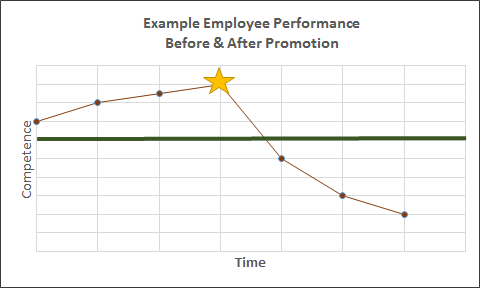At some point or another, we’ve all witnessed some level of incompetence. Whether its on the job, among your peers or even within your family, Dr. Laurence J. Peter argues that:
In a hierarchy, every employee tends to rise to his level of incompetence
This is known as the “Peter Principle“and is based on years of Dr. Peter’s primary research and observations of people within various educational institutions, companies and households. In short, he found that merit-based promotions do not ensure a person will be equally or more successful in his/her new position. People can, in fact, be promoted to a position where s/he goes from being perfectly competent to perfectly incompetent.
The key word in the Peter Principle is “hierarchy.” As an entrepreneur, you may be thinking, “what does a hierarchy have to do with my small business”? Small businesses with fewer than 50 employees tend to be the leanest with less layers (i.e., hierarchy) in their organizational structure. This type of structure allows entrepreneurs and managers alike the flexibility to easily implement quick staffing changeovers and cross-training, making the effects of incompetence less severe. However, as small businesses continue to grow rapidly, so does their need to hire more people.
And that’s where the trouble can start. As you add to your staff, existing employees will likely expect some type of promotion or raise. It’s easier to play musical chairs with your staff when the organization is lean and agile. It’s much more difficult to do for companies with more

employees. These companies cannot recover as quickly from a “bad promotion” and it is critical that the right people are hired (or promoted) for the right job as the employee’s opportunity to move fluidly across an organization diminishes.
The good news is that there is a way to avoid the costs and risks of the Peter Principle in your company. After a recent brainstorming session with two H.R. experts (Cathy Missildine and Debbie King), we agree that using a three-pronged approach of metrics evaluation, process improvement and change management is a safeguard to the Peter Principle.

Business Infrastructure
It’s a disservice to discuss H.R. processes and performance measurement without first ensuring that a stable, repeatable business infrastructure is first in place. To structure your business for success, you should:
- Define the work to perform
- Identify the ideal person to perform the work
- Document processes so that the work can be monitored
Example H.R. Processes include:
- Recruiting
- Interviewing
- Onboarding
- Conducting Performance Evaluations
- Termination
Once all of these elements are in place, you can then proceed with the three-pronged approach to avoiding (or minimizing the effect of) the Peter Principle in your business.
Performance Metrics
As processes are identified and documented, share them with the people expected to perform those processes. Each process should be accompanied with key metrics (KPIs) so that people know how their performance will be monitored. Selecting the proper metrics to use is no small feat since you want to make sure you are measuring the right things.
According to Cathy Missildine, Chief Performance Officer at Intellectual Capital Consulting, “…key metrics are very dependent on what the organization needs to drive their business strategy. Once those are identified measurement is easy. You can measure competencies like customer focus, relationship building, strategic thinker, and decision-making. Also it is important to measure individual SMART goals that are cascaded from the organizational strategy. There’s not a one size fits all answer”.
In addition to identifying performance metrics, you should also:
- Determine the frequency to measure the metrics
- Set the baseline or benchmark for each metric that employees should expect to perform at or above
- Create a forum that allows for ongoing employee feedback as opposed to an annual performance evaluation
See the full Q&A session with Cathy Missildine regarding performance metrics in the presentation further below.
Process Improvement
Process improvement ensures that the right things (metrics) are measured the right way. Below are steps to follow for performance-based process improvement:

- Track the metrics by plotting the data points on a graph. Look for trends below the average or ideal value for each metric.
- Investigate root causes for downward trends.
- Provide feedback to the associated employee(s).
- Determine if poor performance is process-related or a sign of incompetence.
- Establish a corrective action plan that can include a new technology, a new work space, additional training and/or coaching.
- Track the metrics again.
- Determine if the employee can stay in his/her current position, needs to be moved to another position, or must be terminated.
Change Management
Although change management is cited as the last point on the three-pronged approach, it actually is a continuous effort that should happen throughout any endeavor. Debbie King, Sr. Organization Effectiveness Consultant at Evolution Management, Inc., reminds us that, “You can’t communicate too much“.
Debbie also offers the following advice for creating and executing a communication plan for resolving people and process-related issues: “Planning for, and successfully implementing organizational change requires a significant planned engagement with employees and stakeholders to gather their ideas, suggestions and reactions. This time, which organizations often overlook, sets the stage for helping employees understand why the change is necessary and how the changes will impact their position, responsibilities, and future career options”.
According to Debbie, “…Information can be shared through avenues such as:
- Town hall meetings,
- Talking points to be covered in staff meetings,
- Access to senior leaders for questions and clarifications,
- Updates in newsletters and system voice messages,
- Email notices of current change activities, and
- Progress reports of what’s changing and the success the organization is having with the changes”.
See the full Q&A session with Debbie King regarding change management in the presentation below.
It’s important to note that this three-pronged approach is continuous. After cycling through all three areas of performance metrics, process improvement and change management, it’s very possible that the root cause to bad promotions may still lie within your company’s business infrastructure. A shift from incompetence to competence may very well be solved with a new organizational structure or the introduction of new processes altogether.
____________________________________________________________________________
Contact Us today to take advantage of a free one-hour phone consultation to learn how you can use H.R. processes to prevent or reduce the effects of the Peter Principle in your company. ____________________________________________________________________________
About the Feature Image ******
Breaking Bad is hailed as the highest rated TV show of all time. The featured image, (credit: AMC Network Entertainment, LLC), shows two of the main characters – Walter (to the right) and Jesse (to the left). Through self-promotion, Walter successfully transitioned from being a high school chemistry teacher to a formidable producer and distributor of crystal meth. However, Jesse, Walter’s former student and small-time drug dealer, proved to be an incompetent partner as the deals got larger and more sophisticated. I’m in no way advocating drug production, distribution or use, but I am curious to know your thoughts about how Walter could have mitigated this bad promotion. Please share in the comments below!











